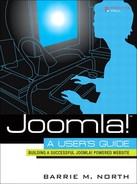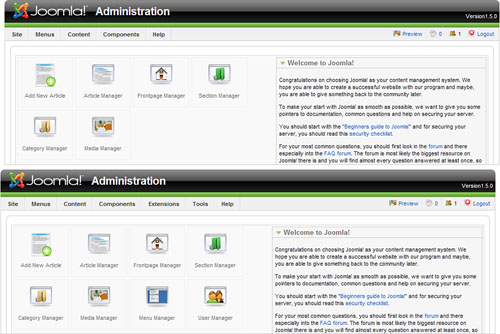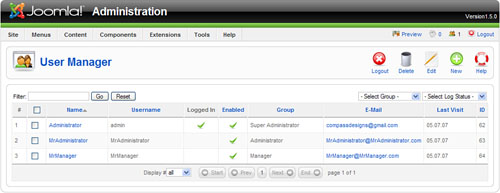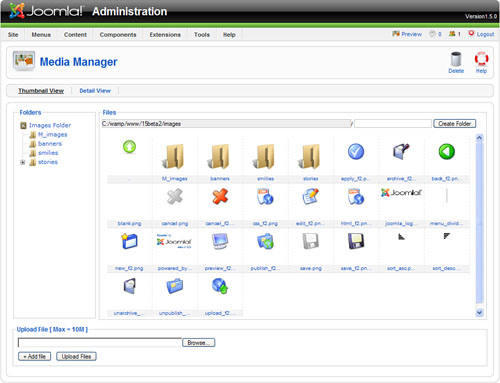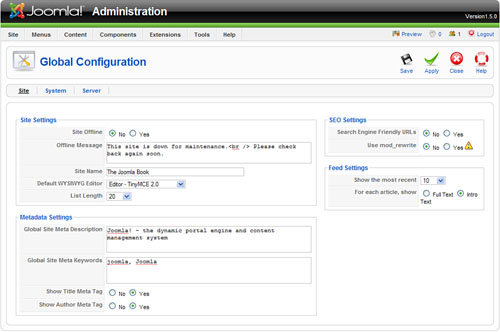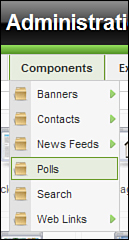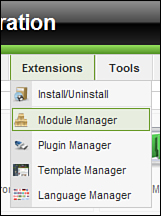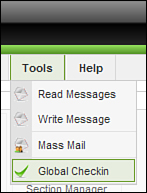The term site administration usually means the day to day tasks of adding content, managing users, and making sure installed components and modules are running correctly. With a properly configured Joomla site, the administration burden is relatively low, and most of the effort can be dedicated to generating that all-important content.
In This Chapter
In this chapter we go on a whirlwind tour of the core administrative functions you’ll need. I don’t go step by step, explaining every last button in the admin backend, but rather pick out key functions, tips, and tricks that you’ll need to know to keep your site humming. I highly recommend getting the official user manual from joomla.org, which does have that wide level of detail.
What is the difference between the frontend and the backend of a Joomla-powered website?
What are the main administrator menu functions?
What types of users are there, and how do they relate to the frontend and backend?
After you install Joomla, you actually have two sites:
The public site (commonly called the frontend) that people view at www.yoursite.com
The administration site (commonly called the backend) whose URL is www.yoursite.com/administrator
While some administration is possible via the frontend of the site, it’s most efficient to manage your site through the backend.
The Least You Need To Know
A Joomla website consists of two sites: the public frontend and a private administrative backend.
When you browse to the backend, you are greeted by a login prompt (see Figure 3.1).
To get any further, you’ll need an administrative password. I hope you remembered it!
Note
I know you never will, but should you ever lose your administrative password, there is a post about how to recover it on the forums: forum.joomla.org/index.php/topic,10985.0.html.
Note
When you installed Joomla, on the final screen, you were asked for an admin password. That is the first account created, and it is given an Access Control Level (ACL) group of Super Administrator. The username is “admin,” and the password will be whatever you entered.
Assuming you log in with a super administrator account, you’ll be presented with the administrative backend of your site. It looks slightly different based on what level of administrator you are.
At the top of the page is a Menu Bar, immediately under that is a Toolbar (in Figure 3.2 it is not visible), and then the large area is the Workspace. The initial page when you first log in to the backend is called the Control Panel.
The Menu Bar is the main navigation for the admin backend. The horizontal menu accesses all the functions of administration:
Site
Menus
Content
Components
Extensions
Tools
Help
On the right of the Menu Bar are some additional information and functions:
A link to preview the site in a new window
A link to your private messages (the number shows how many you have)
A number showing the amount of viewers currently on the site
A button/link to logout
Immediately under the Menu Bar is the Toolbar. It’s collapsed in the initial Control Panel view, but it appears when you navigate to a particular function, like the Article Manager, as you will see in the rest of this chapter’s screenshots.
The Toolbar displays various context-sensitive icon buttons for that function. For example in Figure 3.3, we can see the toolbar from the Article Manager.
While on the Article Manager screen, we have the options of Unarchive, Archive, Publish, Unpublish, Move, Copy, Trash, Edit, New, Preferences, and Help.
In Figure 3.4 we can compare this to the Toolbar that is shown in the Menu Manager. Here we have only Copy, Delete, Edit, New, and Help.
The main body of the admin page is the Workspace, not to be confused with the Control Panel, which is the first view you get after you log in. You will see several different themes of how this is structured. One common format is a basic table, usually used for various managers, articles, menus, and so on.
Caution
There is no current set of layout standards for third-party extensions. The creator of an extension is free to make his administrative interface look however he likes. This can sometimes lead to inconsistency, though, and most developers usually take the lead from the core Joomla for their design.
The Least You Need To Know
The Workspace is the main tool in administering a Joomla site. Different parts of it are visible to different administrators. Third-party extensions will often have Workspaces that are organized differently than the core Joomla functions.
Let’s quickly take an overview of all the functions in the backend. Rather than regurgitate the information already available at help.joomla.org, I’ll only pause to point out things that are worth noting or cautions I think you should know.
As just described, the Menu Bar contains all the functions involved in controlling and managing your Joomla website. I’ll try to make this book useful by adding to the basic information available in the Joomla documentation. I’ll briefly touch on each one in turn, pointing out important roles of each.
The Least You Need To Know
The best place to go for information about the specific functions of all menus and buttons is help.joomla.org. It’s much more accurate and up-to-date than a book can be!
The Site Menu contains several functions that are site-wide, including the very important Configuration screen. Figure 3.5 shows the submenus in the Site Menu.
The Control Panel is displayed when you first log in to the backend. It has icon buttons on the left to access common functions and a series of lists on the right that are Ajax-powered (the cool-looking thing where stuff slides out when you click it).
What is visible in the Control Panel (and in the Menu Bar) depends on what type of admin user you are when you log in.
There are three administrator levels:
Super administrator (highest permissions)
Administrator (medium permissions)
Manager (lowest permissions)
Each administrator level sees slightly different options in the backend. For example, a manager, with the lowest levels of permission, cannot see or have access to the Configuration.
The super administrator view was shown in Figure 3.2. The manager (top) and administrator (bottom) views are shown in Figure 3.6.
The Administrator view does not have global site-wide functions such as configuration. The Manager view does not have extensions or tools. In both cases the number of accessible functions is less than what’s available in super administrator view.
Access Control Levels (ACL) is the grand sounding name given to assigning different functions to different user types. Joomla has nine user levels. You assign these different ACL roles to users through the User Manager in the Site Menu. A list of user types and ACLs can be found in Table 3.1.
Table 3.1. Joomla Access Control Levels
User | Frontend | Backend Functions/Menus |
|---|---|---|
Public Frontend | Browse Only | No Access |
Registered | Can view restricted content | No Access |
Author | Can create content | No Access |
Editor | Can edit content | No Access |
Publisher | Can publish content | No Access |
Manager | As publisher | Media Manager Menu Manager Content Managers Frontpage Manager Component Manager Help |
Administrator | As publisher | As Manager User Manager Install/Uninstall Extensions Module Manager Plugin Manager Global Checkin |
Super Administrator | As publisher | As Administrator Configuration Language Manager Template Manager Template Installer Language Installer Mass Mail |
Selecting the User Manager will bring up a table with all the users that have an ACL of registered or higher, including administrators. An example site with just a few users is shown in Figure 3.7.
Simply put, the User Manager manages users, and only administrators and super administrators can view it.
The filter, shown in Figure 3.7 on the left side, is your search tool for Joomla (it probably should be called “search”). You can enter a name, username, or an email, and it will find all users that have what you typed present in their fields. You can also select a specific group or see only users that are logged in.
Tip
You can’t currently export or import users into Joomla without either a third-party component or accessing the SQL tables directly through a tool such as PHPMy-Admin.
There are nine user levels in a Joomla-powered website. Each level has different permissions and capabilities in the frontend and the backend of the site. Table 3.1 describes each user level.
Note
These permissions are additive, so an editor can do everything an author can—that is, edit and create content.
Guest, registered, author, editor, and publisher are termed frontend users. Very often a Joomla site will have many of these users. This makes it possible to establish content publication workflows. It also allows the responsibility of content publication to be distributed, one of the advantages of a CMS.
If you want lots of content, have lots of authors, editors, and publishers!
Manager, administrator, and super administrators are termed backend users. Usually there is only one super administrator. These users are designed to control the site rather than just focus on content.
The Least You Need to Know
There are two main types of users: frontend and backend. The frontend users manipulate content; the backend users manage the site.
Users are either created automatically though the registration link on the frontend log-on form, or they can be created manually in the backend.
The Media Manager is a one-stop shop to manage all the media that might be used on a site; it includes all types of media, not just images (see Figure 3.8).
The Media Manager shows a basic file manager type view of all files that are in the /images folder. The Media Manager automatically points to this folder; you can’t browse to any other folders in the Joomla installation.
The Media Manager is used to change/add/edit folders and upload or delete media in them. It’s a handy place to put some organization onto your media storage so all your images (for example) aren’t dumped into one big folder, which would make them difficult to locate.
Note
Make sure you have a logical structure for your media. Your actual structure doesn’t matter, but creating folders for certain sections or categories or types of images will make it easier when you have several to handle. It’s worth documenting them too if multiple administrators are on your site.
The Configuration screen is important for your site. It’s only available to super administrators and contains critical settings to keep your site running (see Figure 3.9). It was formerly called Global Configuration on the menu but has been shortened on the submenu to just Configuration. The following list describes the three tabs within Configuration.
Note
New in Joomla 1.5 is the layout of Global Configuration. It has now been split into only three tabs as opposed to the previous ten.
Site—. The initial active tab that contains some very general things about your Joomla website:
Site Offline—. If you take the site offline, visitors will get an offline message. You can customize the offline message with HTML, images, logo, and so on.
Site Name—. Your site name is really vital for SEO in that it always starts any page title (what goes in the blue bar). I cover this in more detail in Chapter 8, “Getting Traffic to Your Site.”
SEO Settings—. This is a new feature in version 1.5: Human readable URLs that are part of the default Joomla installation. These are often described as search engine friendly URLs (SEF). Be careful with these settings. There are changes that need to be made with the .htaccess file in order to get mod-rewrite SEF to work. I’ll talk more about SEF in Chapter 8.
Metadata Settings—. You should keep these very short as they will appear on every single page/article of the site. I recommend using only three to five global site keywords.
Feed settings—. RSS has been greatly improved in 1.5, and you now have finer control of the nature of the feeds. Being able to show the full text for an article means you can syndicate complete articles to other sites.
System—. Most of these settings, such as the debug and cache, you should never need to change. Be certain you have your secret password! If you do manage to lock yourself out, this page will help: forum.joomla.org/index.php/topic,10985.0.html.
User Settings—. Probably the only setting you might want to change is the user settings. Here you can decide whether to allow users to register themselves from the frontend.
Cache (options to set site cache, hopefully speeding it up)—. If you are making a lot of revisions to your site, especially on the template, it’s worth turning the cache off while you do. If you don’t, you will make changes and scratch your head why they don’t take any effect.
Server—. Again, most of the settings in the server tab you should not need to change.
Database (settings about the MySQL database running the site, handle with care)—. I often find myself looking here to remind myself what I called the database. I always seem to forget!
Mail (email options for how the site will send email)—. Some hosts don’t support PHP mail; make sure the mailer matches what your host offers.
Menus are a critical part of a Joomla site. They not only provide navigation but also determine the layout of a page that is linked to through the menu. Menus are difficult to understand, and we examine them in much more depth in Chapter 5, “Creating Menus and Navigation.” For now we will just take a quick overview to provide some context for the more challenging concepts later on.
Figure 3.10 shows the Menus submenu with the sample content installed.
The Menus option has all of the menus that are used in the website. In Figure 3.10, you can see the Menu and Trash Managers and the six menus that are created in sample content of a default Joomla installation.
Note
These menu names are totally arbitrary; they are just names given to menus in a “fake” set of content as an example.
Clicking the Menu Manager will take you to a summary table of all the menus used in the site, shown in Figure 3.11.
Note
Clicking the Menu Items icons in the Menu Manager is the same as just clicking that menu in the drop-down main menu. Using the drop-down menu just skips a step.
Clicking the menu name allows you to change the name of that menu. Clicking the small Menu Items icons shows you what actual links are on that menu. Figure 3.12 shows the Menu Manager when you click “mainmenu” (of the sample content menus).
We revisit menus in much more detail in Chapter 5.
The Content submenu contains the all-important Article Manager. Articles are the individual content items that form the core of a site. This submenu also has the Sections and Category Managers and the Frontpage Manager. The submenu is shown in Figure 3.13.
The Content menu option can be thought of as a big component that presents your articles (content items) in various ways. It contains six different functions:
Article Manager—. Displays all your content items with various ways to filter them to different sections, categories, or authors (see Figure 3.14). You can reorder the articles on any column (ascending or descending) by clicking that column heading.
Article Trash—. Shows the trash for articles.
Section Manager—. Add/edit/delete sections.
Category Manager—. Add/edit/delete categories.
Frontpage Manager—. A component that actually should be in the Components menu option. It controls what content items are viewed on the home page.
Note
Notice that the first article in Figure 3.14 has no section or category. This is because they are uncategorized. This system has completely replaced static items that are in Joomla 1.0.X but no longer exist in Joomla 1.5.
Components are the most important extensions for a Joomla site, the others being modules, plugins, templates, and languages. We will go into more detail on each of these in dedicated chapters. The component menu is where you can administrate the functionality of components that are part of the Joomla core and ones you have installed (see Figure 3.15).
Let’s see what the extensions site (http://extensions.joomla.org/content/view/15/63/1/7/) says about the difference between components, modules, plugins, templates, and languages:
A component is the largest and most complex of the extension types. Components are like mini-applications that render the main body of the page. An analogy that might make the relationship easier to understand would be that Joomla is a book, and all the components are chapters in the book. The core content component (com_content), for example, is the mini-application that handles all core content rendering just as the core registration component (com_registration) is the mini-application that handles user registration.
A more lightweight and flexible extension used for page rendering is a module. Modules are used for small bits of the page that are generally less complex and able to be seen across different components. To continue in our book analogy, a module can be looked at as a footnote or header block or perhaps an image/caption block that can be rendered on a particular page. Obviously you can have a footnote on any page, but not all pages will have them. Footnotes also might appear regardless of which chapter you are reading. Similarly, modules can be rendered regardless of which component you have loaded.
One of the more advanced extensions for Joomla! is the plugin. In previous versions plugins were known as “mambots.” Along with the development of Joomla 1.5, mambots have been renamed plugins, and their functionality has been expanded. A plugin is a section of code that runs when a pre-defined event happens within Joomla. Editors are plugins, for example, that execute when the Joomla event “onGetEditorArea” occurs. Using a plugin allows a developer to change the way her code behaves depending on which plugins are installed to react to an event.
New to Joomla 1.5 and perhaps the most basic and critical extension is a language. Languages are packaged as either a core language pack or an extension language pack. They allow both the Joomla core as well as third-party components and modules to be internationalized.
So a component is a specialized mini-application that runs in Joomla as part of its core. There are many hundreds available for free and commercially from third-party providers. You can find out more about them at extensions.joomla.org.
Note
Some components make use of modules and plugins as well as the component itself to achieve full functionality.
The default components that ship with Joomla are
Content
Banners
Contacts
Newsfeeds
Polls
Web Links
Extensions come in several types: components, modules, plugins, templates and languages. Components are fundamental to the functionality of a Joomla site and have their own menu. The rest can be found in the Extensions submenu as shown in Figure 3.16.
The Extensions menu holds all the, well, extensions you might have installed into Joomla to extend its functionality. Each of the smaller extensions has its own manager.
Note
In the Extensions menu, there are managers for modules, plugins, templates, and languages. The manager for components, however, is in a separate menu item. This is because components are more complex than the aforementioned extensions, and it would make navigation difficult if they were all in together—so they are given a menu item of their own.
The Install/Uninstall menu link takes you to the Extensions Manager. Here you can install new extensions and uninstall ones you don’t want any longer. The manager is shown in Figure 3.17.
Joomla allows the installation of extensions from their packaged installable zip files. Joomla 1.5 will automatically detect what type of extension is being installed. The Install/Uninstall page also details individual extensions on their own pages so they can be uninstalled.
To be able to be installed automatically into your Joomla site, the package must be zipped up and have an XML file with instructions to Joomla about how to unpack it.
The Module Manager controls the parameters (options) and placement of all of the modules in a Joomla site, shown here in Figure 3.18.
Modules can be thought of as mini-components. Where a component always displays its content in the main body, modules display their content in designated places. For example, the Log In module might have its location set as “left” (in most templates this would be in the left column).
Often a component will have a number of modules bundled with it. For example Virtuemart, a popular shopping cart component, has a module that shows the latest items for sale.
Tip
The module locations are totally arbitrary, based on the template designer’s whims. If I wanted to, I could have all my “left” modules be in a column located on the right. This is not something to be concerned about, though. Most designers generally follow reasonable conventions. It’s worth noting, however, if you are using a free template from who knows where.
The Plugin Manager is where you can control the options of all the plugins you have installed. Formerly called mambots, these plugins add small site-wide functionality. The Manager is shown in Figure 3.19.
Many of these plugins don’t have options; they simply provide some function. Some examples are
Content—mail Cloaking—. Automatically checks all pages for email addresses and replaces them in the code by JavaScript so email spam bots can’t harvest them.
Content-Load Module—. This allows you to load modules into the middle of a content article.
The Template Manager shows all templates currently installed (see Figure 3.20).
The Template Manager controls how a template is implemented on your site. You can edit the HTML or CSS files, assign a template to specific pages, and preview it with the module positions shown.
Some of the new features in Joomla 1.5 allow templates total control over how the Joomla core, components, and modules are outputted without having to make any hacks. This is a very versatile and powerful feature, and we’ll look at it again later in Chapter 9, “Creating a Pure CSS Template.”
Joomla 1.5 has several powerful new features with respect to internationalization. The Language Manager shows all language packs currently installed (see Figure 3.21).
Joomla 1.5 has a UTF-8 character set, which means you have RTL (right to left) support and language packs for backend, installer, and help systems. This makes Joomla 1.5 a complete application for use in any language or combination of languages, which is unique among open source CMSs. There are over forty accredited translations available for the core, ranging from German or Swedish to Bulgarian or Arabic. You can read more about them at http://dev.joomla.org/content/view/42/66/.
The Tools submenu is not visible to managers. It contains some general tools used in administering your site (see Figure 3.22).
The Tools menu appears for administrators and super administrators only. It has a very basic private message system (PMS) and a basic mass mail. The PMS receives notification when a piece of content is submitted (for example), and the mass mail function allows you to email all your users. It should be used with extreme caution, however, as sending emails in this way is likely not to conform to modern CAN-SPAM regulations. To send bulk email, you will need an appropriate third-party extension. Some reviews can be found at my blog, compassdesigns.net.
The Global Checkin tool checks in all content items that might be open or have been opened for editing. Joomla has a built-in function that allows only one person to edit a content article at a time. This is very important for content management. It does this by “checking out” items so no one else can open them. However, if someone uses his back button or closes his browser while editing, the item can remain checked out. The Global Checkin provides a function for the super administrator to make all content items available for editing again. Needless to say, the super administrator would need to make sure that no one was editing at the time.
The Help submenu contains links to the official Joomla documentation that will open in the backend in a wrapper (see Figure 3.23). This means you always have access to the most current documentation.
Joomla has a useful Help function built into the administrative backend. It’s a searchable knowledge base of most basic functions and is a mirror of the Help documentation at help.joomla.org.
Note
At the time of writing, the Help site for 1.5 was not completely set up. Depending on when you are reading this book, you might well find the documentation for 1.5 still in development.
Another great place to get questions answered of a more troubleshooting nature is the official Joomla forums, forum.joomla.org. It’s a large community, and there are many users that are immensely helpful.
When you use the Preview function, Joomla opens a new browser window with the frontend of the site shown. The preview link is in the right of the Menu bar, as shown in Figure 3.24.
Joomla contains a useful feature that involves taking the site offline. You can find it at Site>Configuration. When you make the site offline, visitors are greeted with the simple message shown in Figure 3.25.
The useful part of this is if you now log in as an administrator, you get to see the site as outside visitors would see it. This is tremendously useful as you can work on a site before going live and see your edits, but the public will be unable to see it.
This is made even more useful in that you can adjust the offline message to your taste. Maybe you want to include a brief message about your site and that it is coming soon. You can also add as much HTML to the Site Offline message as you like, even more than you think might fit into the box in the Global Configuration. You can even include images using an <img> HTML tag.
This chapter described both the frontend and backend of a Joomla-powered website and quickly toured how to navigate the administrative backend. The menus we have covered thus far are referred to often throughout the rest of this book, and submenus to be navigated will be represented in this format: Site>Configuration (this example takes you to the Global Configuration screen).
As we looked at our overview of the backend, we saw that
A Joomla website consists of two sites: the public frontend and an administrative backend.
The best place to go for information about the specific functions of all menus and buttons is help.joomla.org. It’s much more accurate and up-to-date than a book can be!
The Control Panel is the main tool to administer a Joomla site. Different parts of it are visible to different administrators. Third-party extensions will often have Workspaces that are organized differently than the core Joomla functions.
There are two main types of users: frontend and backend. The frontend user types manipulate content, while backend user types are responsible for site management.
